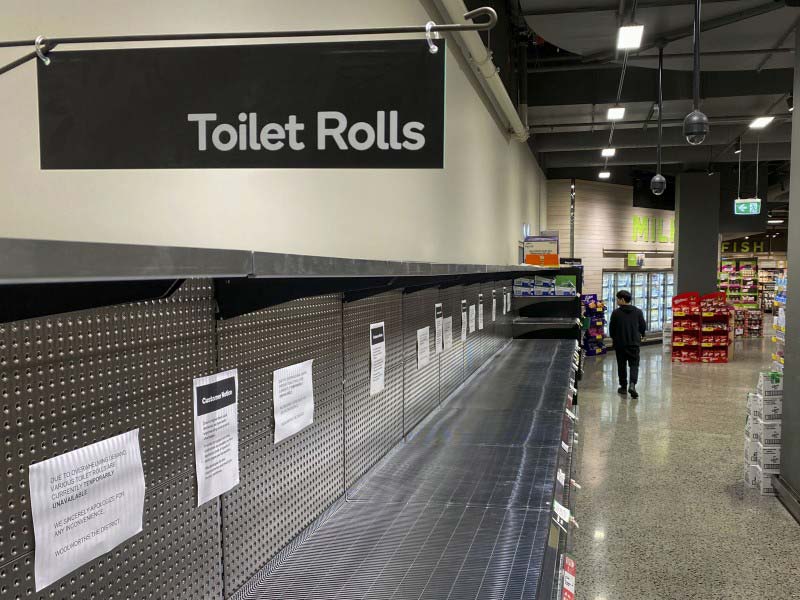PODCAST: How the COVID-19 toilet paper shortage is changing logistics
Under pressure to get essential products to consumers, experts are rethinking how goods are shipped and stored
As the coronavirus pandemic started to unfold, shoppers rushed to stock up on household staples in preparation for lockdowns and the uncertainty ahead.
During the buying frenzy, toilet paper quickly became an international emblem of the broader shortages on supermarket shelves. Scenes on television and social media of people scrummaging over the commodity only helped fuel demand for the humble toilet roll.
But with images showing warehouses packed full of toilet paper, confusion ensued.
“The challenge with toilet paper hasn’t been an inability to make enough product,” says Jamie Guerra, head of industrial and logistics – Australia, JLL. “It’s being able to get the product to where it needs to be.”
The shortage of toilet paper was seemingly everywhere. In Hong Kong, a gang raided a store for 600 rolls. Images of empty supermarket shelves in Singapore, the UK and the US were widely shared.
In Australia, the rush for the product was among the most acute. Major supermarkets were selling a weeks’ worth of toilet paper in just one day. Ethical e-commerce toilet paper brand Who Gives a Crap reported a near 1,000 percent rise in sales.
While frustrated consumers have been scratching their heads, experts on the coalface have turned their thoughts to how the system that gets essential goods to consumers needs to change. Ideas range from adjusted delivery curfews, to more flexible leases and decentralising distribution centres.
The distribution centre
The pandemic has quadrupled normal activity levels in the logistics sector as manufacturing ramps up not just for toilet paper, but also for other high demand goods such as food staples and medical supplies.
Distribution centres – the strategically-located warehouses where factory goods are unloaded and then shipped to supermarkets – are the hub of this activity. But with many operating over capacity, transport brokers have been scrambling to negotiate short-term space, especially in areas where business has slowed.
In Australia, the discount department store Kmart has converted three of its stores into fulfilment, or ‘dark stores’, which will be closed to the public, but operating to fulfil online orders, to meet new demand.
Flexibility is likely to reach new levels, Guerra says.
“The challenge for landlords will be that flexibility is not the norm because of the way finance is structured, and everything else in relation to asset values and shareholder returns,” he says. “But we are seeing more of it, and the increasing institutional ownership of industrial property is going to drive it further, as businesses can upscale and downscale within a landlords’ portfolio.”
The inevitable boom in entrepreneurial activity will force landlords’ hands, says Amy Bentley, general manager of supply chain solutions - Australia and New Zealand, at third Party logistics (3PL) company Toll Group.
“A lot of those smaller businesses won’t have the volume to warrant going to a 3PL, but they might want to band together to share a single property,” she says. “And say they only want to commit to four weeks at a time, or lease from week-to-week? I do think there is going to have to be an adjustment.”
Both Bentley and Guerra are hopeful that flexibility will also extend to trucks, which have been a critical link in the logistics chain. In Australia, they deliver 76 percent of Australia’s non-bulk freight, according to the Australian Trucking Association.
In metropolitan areas, and particularly Sydney, curfews set by local councils to restrict loading dock operations outside business hours are a bone of contention, and the lifting of those restrictions to allow 24-hour supermarket deliveries has been crucial to moving essential goods, Bentley says.
“One of the things we have been talking about for a long time is how we can do more deliveries at night,” she says. “It means we have fewer trucks on the road when there are people commuting, there is less environmental impact, drivers get to where they need to be quicker and there is therefore a better cost outcome.”
Supply chain and manufacturing
For Australia and other countries, the pandemic has exposed a heavy reliance on China for packaging and product components. Curtailed production in China due to the virus has caused a significant knock-on effect, Guerra says.
“Questions are now being asked about the right balance of onshore and offshore production and levels of safety stock,” he says. “It has particularly caught us off guard for critical items such as face masks, hand sanitisers and medication.”
Storing more stock close to major population hubs will be a strategy that gathers momentum, Bentley adds.
“Until now we’ve typically looked to consolidate major distribution centres, but we're probably going to see a shift to decentralising these centres in locations closer to the customer base."
A key consideration for companies that build greater resilience into their supply chains will be competitiveness, says Allan Frydman, managing director of supply chain consultancy, DC Works.
“As consumer demand grows again for an increasing array of goods at constantly decreasing prices, companies with resilient supply chains will come under significant cost pressure from those without inbuilt resilience,” Frydman says.
“The real question is how long will consumers feel the impact of COVID-19, and will they be willing to pay a higher price for their goods over the long term?”




